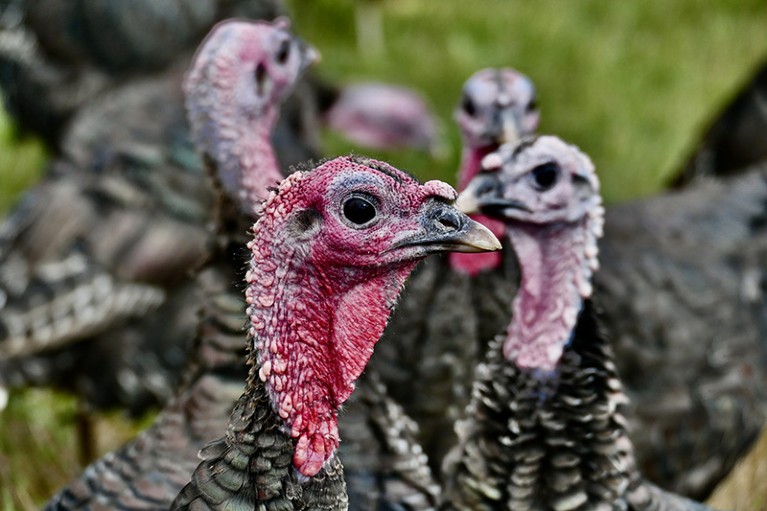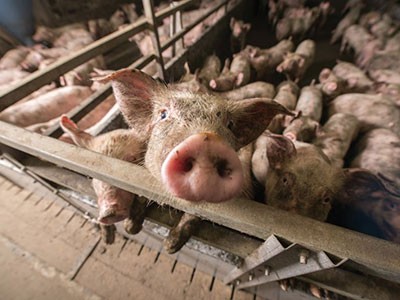[ad_1]

The United Kingdom has put in place strict measures to protect poultry, such as these free-range turkeys, and to gain control of a raging bird-flu outbreak.Credit: Geoffrey Swaine/Shutterstock
Avian influenza is on the rampage. In the past few days, both France and the United Kingdom have announced new biosafety measures aimed at curbing the swiftly spreading illness. Dozens of infected penguins in South Africa have died recently, and on Wednesday South Korea reported its first case in six months. In the United States, the disease is driving up prices for turkey a month before Thanksgiving, in which the bird plays a central part. The prevalence of the disease is the highest on record in Europe, and the number of domesticated birds that have died over the past year is approaching a record in the United States. So why is bird flu so bad right now?
The bird flu that is currently running amok in Europe and North America is predominantly caused by a strain called H5N1 — one of several that is classified as a highly pathogenic avian influenza (HPAI) virus, because of its high death toll in poultry.
Europe, Asia and Africa have had many flare-ups of HPAI viruses since the late nineteenth century. For about a century, outbreaks were limited mainly to poultry, and the culling of affected flocks usually kept the disease from spreading widely in wild birds.
Virus with a difference
But since the early 2000s, researchers have noted a sustained spread of avian flu among wild birds. Over the past year, this transmission has increased drastically. The disease also seems to be spreading to mammals more frequently. These unprecedented patterns of transmission mean that “something is quite different about this virus this go around”, says Rebecca Poulson, a wildlife-disease researcher at the University of Georgia in Athens.
The situation is especially unusual for North America. An HPAI strain has been detected in wild birds there only once before, between 2014 and 2016, after wild birds spread the disease from Eurasia to Alaska. That outbreak led to the deaths of more than 50 million domestic birds in the United States alone, at a cost of US$3 billion. But then the virus “seemed to sort of vanish”, says Andy Ramey, a wildlife geneticist at the US Geological Survey Alaska Science Center in Anchorage.
Flu on the farm
In December 2021, the highly pathogenic H5N1 strain popped up again in North America, this time in the east. Researchers expect viruses to make the short journey across the Bering Strait to western North America, but “we weren’t really expecting this one to sort of sneak in the back door”, Poulson says. Since then, the disease has been circulating uncontrollably in wild birds rather than remaining mostly contained to poultry farms, where cramped conditions can promote viral spread. In both Europe and the United States, the high number of infected wild birds might make it easier for the virus to spill over into domestic flocks, she notes.
Poulson says it was inevitable that wild birds would carry an HPAI strain to North America again one day. “It was going to happen,” she says. “And it just happened to be now.”
Mutations matter
No one knows why this outbreak hasn’t fizzled out, but virologist Louise Moncla at the University of Pennsylvania in Philadelphia says that there are a few leading theories. One is that genetic mutations have increased the virus’s ability to replicate, allowing it to spread more efficiently than previous strains could. Another is that mutations have allowed the virus to infect a broader range of bird species than previous strains were capable of. Researchers are testing these ideas, but so far there are “more questions than there are answers”, says Moncla.
This strain of HPAI also seems to have developed a propensity for jumping to mammals, such as seals, bobcats and skunks, although there’s no evidence it can spread from one individual mammal to another. Human cases are rare, even in Europe, where frequent poultry outbreaks have created opportunities for people to become infected. This gives Poulson hope that the virus won’t evolve to infect people more readily, but “the elephant in the room: we don’t know”, she says.
Maybe here to stay
When, if ever, will this outbreak die down? The coming weeks are likely to see many cases, Ramey says, because birds are congregating to migrate together. The infection numbers might go down outside the migratory season, but “I don’t know if the underlying situation is truly getting better”, he says.
Poulson thinks it is likely that the virus has passed the point at which it could have disappeared from North America again. “There’s no sign that this virus is being suppressed or held back at all,” she says.
[ad_2]
Source link


